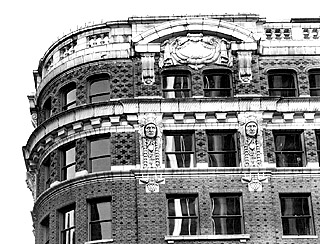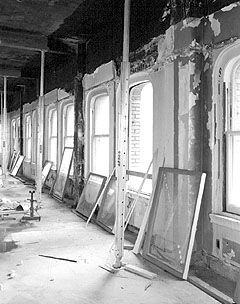
DJC.COM
March 30, 2006
Historic preservation projects can be green
GGLO

Wishkoski
|
Yet Seattle's growing population is faced with long commutes, traffic congestion, rising development costs and a shortage of affordable housing.
These concerns — as well as diminishing resources and the shrinking availability of developable land — are persuading building owners and public officials to see our existing building stock as a critical resource, one that can be renovated and adapted for new uses.
Preservation vs. conservation

Photos by John Stamets
The brick and terra-cotta exterior of the century-old Cobb Building remained untouched by a renovation. The former medical office building will reopen as luxury apartments in July.
|
The words preservation and conservation, by definition, are almost interchangeable. Preservation is an end in itself — to keep or maintain intact, safe, unaltered. Conservation is a process that preserves, protects and maintains during physical change.
Historic preservation strives to make our cultural heritage tangible by preserving a building or a place. Yet where sustainability intersects with historic renovation, definitions of preservation and conservation can be very different indeed.
Historic renovation is not a path for the faint-hearted. To preserve the cultural history and conserve valuable resources of an existing building, one must undergo the painful process of addressing building components and systems separately.
Some building elements may be replaced, others may be improved and still others must remain entirely untouched. Layering sustainability requirements over renovation goals adds another dimension of complexity.
Adaptive reuse
The Cobb Building, at Fourth Avenue and University Street in downtown Seattle, demonstrates the interplay of all of these issues.
Built in 1910, the 11-story structure made history as the first commercial building west of the Mississippi to be designed exclusively for medical and dental offices and surgery.
After almost a century of continuous use, the building could no longer compete with modern office properties. The owner, the University of Washington, wished to preserve the historic and cultural features of the Cobb Building while repositioning the property to provide revenue for its endowment.
Several factors were critical to making historic renovation financially feasible. The building's features — a narrow floor plate; large, operable windows that provide better light and natural ventilation than most contemporary buildings; a prime location in the downtown shopping and cultural district; plus the availability of historic tax credits — all suggested adaptive reuse from medical offices to apartments.
Once historic renovation combined with adaptive reuse had proven itself a viable financial alternative to new construction, the development team faced the final hurdle — integrating sustainability in pursuit of LEED certification.
Sustainable renovation
Unico Properties, developer and manager of the Cobb, takes sustainability seriously.
"Building green has become part of Unico's DNA," said CEO Dale Sperling. "It's all about creating healthy and productive environments for the people who live and work in our buildings. We knew greening the Cobb would be a challenge, but we balanced historic renovation with pursuit of LEED and made sustainable attainable. It was simply the right thing to do."
Many feel that sustainability is not compatible with aging structures, in part because superior new technologies can not be efficiently integrated. Unfortunately, this idea is somewhat reinforced by the U.S. Green Building Council's treatment of resource reuse issues in its LEED certification program, which awards only three points (out of 69) for the reuse of an entire building, including its interior walls.
In contrast, consider the conservation perspectives of lifecycle value assessment and embodied energy. From an embodied energy standpoint — that which has already been extracted, harvested, processed and constructed — conservation offers an enormous sustainable advantage over any kind of virgin or newly manufactured material.
At the Cobb, the bricks and terra-cotta that comprise the historic exterior walls have remained untouched during the renovation. The building's roughly 308,000 bricks, each with an embodied energy value of 14,300 British thermal units, represent 4.4 million BTUs of energy expended in the original construction of the building, or 1.3 million kilowatt hours of electricity.
Given that the average household in the U.S. uses about 8,900 kilowatt hours of electricity each year, these bricks are equivalent to the amount of energy needed to power 145 homes for a year. This is only one dimension of embodied energy savings for one material, not including the value of the labor to set them in place nearly a century ago.
Compromises
Many sustainable features have been incorporated into the renovation of the Cobb easily and without compromise to its historic qualities.
Obviously, reuse rather than demolition prevents valuable resources from entering the waste stream and reduces the consumption of new construction materials. New materials that are being used — including metals, wallboard, insulation, concrete and acoustical ceiling tile — contain recycled content. The carpet, adhesives, sealants, paint and composite wood have a low content of volatile organic compounds.
Sustainable design, after all, does not necessarily mean using expensive, technological solutions. Rather, it encourages design that complements local conditions, taking best advantage of available light, wind, rain and terrain. This perspective, far from being new, harkens back to techniques often found in historic structures.
The Cobb's large, operable windows, for example, enhance daylighting and natural ventilation. These features were thoughtfully designed almost a century ago to speak to the same concerns that we face today — health and productivity.
But the windows also demonstrate the conflicts that can arise from pursuing sometimes-contradictory goals.
A sustainable renovation would seek to maximize the efficiency of the building envelope in order to improve thermal comfort and reduce energy use. But the historic terra-cotta exterior and window sash precluded reglazing the windows with higher-performance glass or adding exterior insulation to the walls. Instead, removable low-e film was applied to the glass to improve thermal performance and comply with the state energy code.
Incorporating new heating, ventilation and air-conditioning systems required further compromise. Though the building offers natural ventilation with its operable windows, its busy downtown location raised concerns about noise and poor air quality. As a result, a hybrid heat pump system was installed to provide heating and cooling in each apartment.
When in cooling mode, rejected heat will preheat domestic hot water, saving about 5 percent a year over a conventional forced air system.
Necessity of conservation

The Cobb’s large, operable windows allow natural light and ventilation. Low-e film was applied to the glass to improve thermal insulation.
|
In our time, historic preservation can and must be accomplished with the companion goal of sustainability. Both involve tradeoffs, a balancing act of goals and benefits.
If preservation is a luxury for some, conservation is a necessity for all. Issues of common good and global resources are no longer abstract concepts — they register a little closer to home every day.
As we as a city define and carry out our urban environmental objectives, we must bear in mind the value of not only our historic and cultural resources but also the embodied energy resources of our existing building stock.
In this way we will express respect for the built environment as well as our natural one.
Michael S. Wishkoski, a LEED-accredited principal at GGLO, focuses on multifamily projects with a special interest in adaptive reuse and historic preservation.
Other Stories:
- Tips for designing an energy-efficient building
- Toward a sustainable future in South Lake Union
- Low-impact development gets a test in Renton
- Smart lighting design: go for timeless, not trendy
- Brownfield project demonstrates Seattle's creative know-how
- 3 advances show the future of site development
- What does a sustainable school cost?
Copyright ©2009 Seattle Daily Journal and DJC.COM.
Comments? Questions? Contact us.